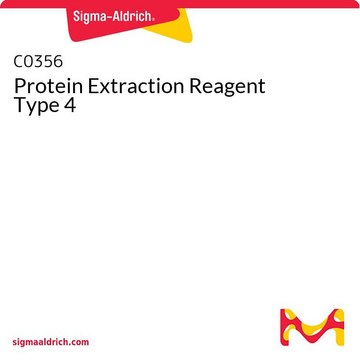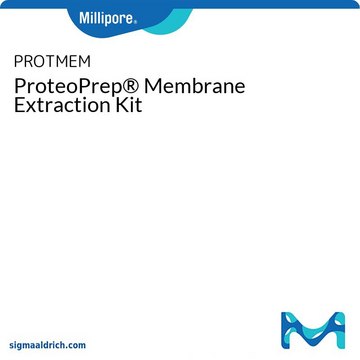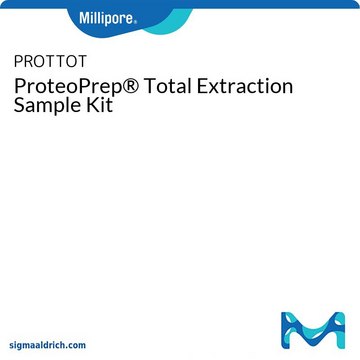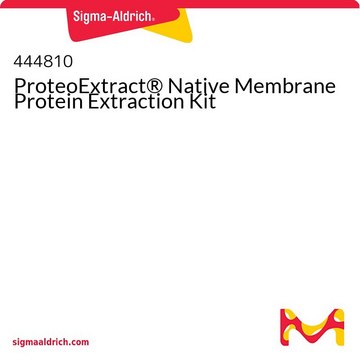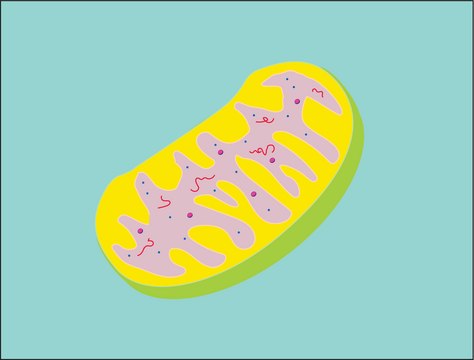Recommended Products
Application
This kit features new and innovative detergents, and uses specially formulated reagents and an optimized protocol designed to generate two prepared subcellular fractions that are uniquely ready for two-dimensional (2D) electrophoresis.
- Fraction 1: Soluble/Cytoplasmic Proteins
- Fraction 2: Membrane Proteins
Features and Benefits
- Innovative detergent preparations - Highly improved solubility allows for higher protein loads and greater visibility of low abundance proteins on 2D gels.
- Two pre-mixed solubilizaton solutions - Generates two distinct populations for easy 2D analysis.
- Pre-measured reducing and alkylating reagents - Easy-to-use reagents provide improved IEF resolution.
- Pre-weighed dry blends - Stable and easy to reconstitute
- Conveniently Packaged - No waste. Use only the amount needed.
Legal Information
ProteoPrep is a registered trademark of Merck KGaA, Darmstadt, Germany
Signal Word
Danger
Hazard Statements
Precautionary Statements
Hazard Classifications
Acute Tox. 3 Oral - Aquatic Chronic 2 - Carc. 2 - Eye Dam. 1 - Repr. 1B - Resp. Sens. 1 - Skin Corr. 1A - Skin Sens. 1 - STOT SE 3
Target Organs
Respiratory system
Storage Class Code
6.1C - Combustible acute toxic Cat.3 / toxic compounds or compounds which causing chronic effects
Flash Point(F)
Not applicable
Flash Point(C)
Not applicable
Choose from one of the most recent versions:
Already Own This Product?
Find documentation for the products that you have recently purchased in the Document Library.
FcR? Presence in TCR Complex of Double-Negative T Cells Is Critical for Their Regulatory Function.
Thomson, C.W., et al.
Journal of Immunological Methods, 177, 2250-2257 (2006)
W M Freeman et al.
Neuroscience, 159(1), 183-195 (2009-01-13)
Declining cognitive performance is associated with increasing age, even in the absence of overt pathological processes. We and others have reported that declining cognitive performance is associated with age-related changes in brain glucose utilization, long-term potentiation and paired-pulse facilitation, protein
Susanne K Pedersen et al.
Journal of proteome research, 2(3), 303-311 (2003-06-20)
Abundant and hydrophilic nonmembrane proteins with isoelectric points below pH 8 are the predominant proteins identified in most proteomics projects. In yeast, however, low-abundance proteins make up 80% of the predicted proteome, approximately 50% have pl's above pH 8 and
Diliana Dancheva Simeonova et al.
Molecular & cellular proteomics : MCP, 8(1), 122-131 (2008-08-22)
We present here a new approach that enabled the identification of a new protein from a bacterial strain with unknown genomic background using a combination of inverted PCR with degenerate primers derived from N-terminal protein sequences and high resolution peptide
Maria De Angelis et al.
Electrophoresis, 31(13), 2126-2136 (2010-07-02)
Food allergy is recognized as one of the major health concerns. It is estimated that ca. 4% of the population is affected by food allergenic disorders. Food allergies are defined as IgE-mediated hypersensitivity reactions. Foods such as peanuts, tree nuts
Our team of scientists has experience in all areas of research including Life Science, Material Science, Chemical Synthesis, Chromatography, Analytical and many others.
Contact Technical Service